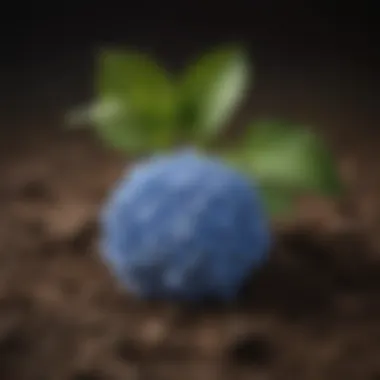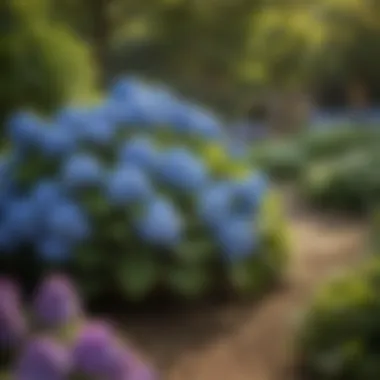Comprehensive Care for Hydrangeas: Techniques and Insights


Intro
Caring for hydrangeas can be both rewarding and challenging. These plants provide vibrant colors, responding to different factors. Understanding their needs is essential. This article will explore essential care techniques for hydrangeas, covering watering, soil types, pruning, and managing pests. It also includes information about the different varieties and how to create ideal growing conditions.
Essential Care Practices
Hydrangeas have unique requirements depending on their variety. All hydrangeas thrive in varying amounts of sunlight and watering schedules. They can be grown in different soil types, but they prefer nutrient-rich, well-draining soils. Regular maintenance ensures these plants flourish, and proper identification of issues can prevent larger problems.
Types of Hydrangeas
There are many varieties of hydrangeas, including Hydrangea macrophylla, Hydrangea paniculata, and Hydrangea arborescens. Each type has specific care needs, such as different pruning techniques and flowering times. Understanding these differences is crucial for success.
Understanding the specific variety of hydrangea is key to providing the right care.
This focus on individual variety requirements can make your hydrangeas healthy and vibrant. Proper treatment also improves blooming in various growing conditions.
Common Care Techniques
Watering Hydrangeas
Consistent watering is vital. Hydrangeas thrive with adequate moisture. To ensure hydration, use a deep watering technique during dry spells. Adequate moisture prevents wilting and promotes vibrant blooms. Check the soil regularly, as overwatering can lead to root rot.
Soil Requirements
Hydrangeas generally prefer slightly acidic soil. Testing soil pH helps establish ideal conditions. Incorporate organic matter, like compost or peat moss, for improved structure and fertility. This promotes root health and nutrient accessibility.
Pruning Hydrangeas
Pruning depends on the type of hydrangea, as some bloom on old wood while others bloom on new wood. Pruning in late winter or early spring is generally recommended to control the size and encourage new growth. Always use sharp tools to make clean cuts, minimizing damage.
Pest and Disease Management
Common pests impacting hydrangeas include aphids, spider mites, and whiteflies. Regular check-ups ensure you catch early signs of infestation. Incorporate natural solutions to manage these pests without chemical intervention. Mismanagement can lead to diseases, like powdery mildew. Vigilance is essential for ongoing health.
Seasonal Care
Different seasons have different needs for hydrangeas. In fall, apply mulch to protect roots. Winterizing techniques keep plants healthy through harsh conditions. In spring, fertilizers specific to flowering plants can stimulate growth. Finally, in summer, enough water and shading can enhance blooming.
Prolusion to Hydrangeas
Hydrangeas are captivating plants that present gardeners with diverse choices in colors and forms. Understanding hydrangeas is essential for anyone keen on cultivating greenery that can brighten up any space. The care they require is specific and varies by variety, making it imperative to delve into their needs for successful growth.
Proper care for hydrangeas can enhance their blooming potential and health. The first step is to garner knowledge on the specific varieties one may choose. Each variety has disctinct characteristics, leading to different care requirements. Appreciating these differences aids in providing optimal conditions.
Moreover, the act of cultivating hydrangeas grants rewards beyond visual aesthetics. These flowers provide joy during blooming seasons and contribute biodiversity to home gardens by attracting pollinators. They can also serve as a tool for ecosystem balance in urban areas, fostering interaction between flora and fauna while benefiting the environment. Thus, investing time and effort into understanding hydrangeas paves the way for appreciation of their unique beauty and importance.
Understanding Hydrangea Varieties
There are several types of hydrangeas that capture the interest and intrigue gardeners. Typically, they can be classified into main categories: Hydrangea macrophylla, Hydrangea paniculata, Hydrangea arborescens, Hydrangea serrata, and Hydrangea quercifolia. Each variety responds differently to cultivation, temperature changes, and soil composition.
Identifying each form’s key traits enhances cultivation strategies. Hydrangea macrophylla displays its beauty in pink or blue shades, significantly influenced by soil pH. Hydrangea paniculata, on the other hand, bears cone-shaped flowers ideal for cutting. Understanding these distinctions sets the foundation for improved care.
Reasons to Cultivate Hydrangeas
Hydrangeas provide multiple successful reasons for cultivating them in home gardens. Here are notable considerations:
- Aesthetic Appeal: They add color and elegance to landscapes with blooms that vary by type.
- Pollinator Attraction: Hydrangeas attract bees and butterflies, supporting local ecosystems.
- Adaptability: They can flourish in various environments and climates, making them suitable for different regions.
- Longevity: With the right care, hydrangeas can thrive for several years, becoming lasting features in any garden.
Cultivating hydrangeas represents not just an act of beautification but contributes meaningfully to personal spaces and the broader ecosystem. Fully engaging with their diverse varieties allows for informed decision-making to elevate one’s gardening practices.
Optimal Growing Conditions
Optimal growing conditions are crucial in ensuring that hydrangeas thrive. When the right environment is achieved, plants will exhibit healthy growth, vibrant blooms, and increased resistance to diseases and pests. Understanding the specific growing conditions for hydrangeas sets the foundation for successful cultivation.
Light Requirements


Hydrangeas have varying light needs depending on the variety. For instance, Hydrangea macrophylla prefers partial shade, especially in hot, dry climates. In contrast, Hydrangea paniculata can tolerate full sun. Most hydrangeas thrive in about four to six hours of sunlight each day.
- Full Sun: Certain types enjoy strong achin', like Hydrangea paniculata.
- Partial Shade: Recommended for Hydrangea macrophylla, it prevents leaf scorch by breaking strong afternoon sun.
When picking a spot for these plants, consider observing sunlight patterns in your garden.
Soil Preferences
The soil serves as the nutrient source for hydrangeas. They typically prefer well-draining, fertile soil with a pH ranging from 5.2 to 6.2. This acidic environment can enhance blue blooms in varieties sensitive to pH changes. Some key points to consider:
- Drainage: Unwanted moist conditions can lead to root rot, which can seriously harm plants.
- Organic Matter: Incorporating compost or well-rotted manure improves soil structure and nutrient availability.
Ensuring optimum soil conditions can directly correlate with the flowering capacity and overall health of hydrangeas.
Climate Considerations
Hydrangeas flourish in temperate climates, often favoring regions with distinct seasons. However, hardiness depends on specific species. Many thrive in USDA zones 3 through 9.
- Heating: Such conditions can lead to early budding in spring, which might be susceptible to late frosts. It's crucial to monitor temperature drops that could jeopardize blooms.
- Humidity: Most hydrangeas appreciate higher humidity but tolerances vary.
Understanding these climate aspects helps in selecting the most appropriate types of hydrangeas for each environment.
To achieve lush growth, awareness of light, soil, and climatic conditions is essential.
Watering Practices
Watering practices are fundamental to the health and vitality of hydrangeas. These plants thrive in conditions where moisture levels are well managed. Proper watering prevents stress on the plants, allowing for lush foliage and vibrant blooms. It's essential to understand both the quantity and frequency of watering, as over or underfeeding them with water can lead to various problems.
Frequency and Quantity
The frequency of watering hydrangeas largely depends on environmental factors and the specific variety you are dealing with. Generally, during growing season, which typically spans from spring through early autumn, hydrangeas should be watered more often compared to the winter months.
- For newly planted hydrangeas, a routine of watering every other day may be necessary until the roots establish.
- In warm, dry weather, most varieties will benefit from deep watering about two to three times per week. This keeps soil moist but not saturated.
- The general guideline is to provide roughly one inch of water per week, including rainfall.
- You can check soil moisture by inserting your finger an inch into the soil. If it feels dry, it likely needs water.
Carefully observing local weather patterns is also crucial. If there is excessive rainfall, adjust your routine accordingly, as hydrangeas won't need as much manual watering. Conversely, during long dry spells, frequency may need to increase.
Signs of Underwatering and Overwatering
Recognizing the signs of inadequate watering is crucial in hydrangea care. Underwatered hydrangeas often display:
- Wilting leaves, which may curl or droop.
- Leaves turning brown or crispy.
- Stunted growth, indicating that the plant is not thriving.
On the other hand, overwatering, which can lead to root rot, manifests through:
- Yellow leaves, beginning with the lower leaves.
- Soil that feels soggy or retains excess water.
- Foul smell from the soil, a sign of decay.
Monitoring these symptoms can provide valuable insights for managing your hydrangea's watering needs, ensuring they flourish in your garden.
Remember, a consistent watering routine is key, but always tailor it to specific soil conditions and weather scenarios for best results.
Soil Preparation and Fertilization
Soil preparation and fertilization are crucial for nurturing hydrangeas. For healthy growth, these plants need a rich and well-structured soil environment. Proper soil preparation ensures that the hydrangeas have the necessary nutrients available for uptake, and effective fertilization helps them achieve their full flowering potential. This section explores how to test soil pH and the use of organic and chemical fertilizers.
Testing Soil pH
Understanding the soil pH is an important step in the cultivation of hydrangeas. The preferred range for hydrangeas is between 5.5 and 6.5. pH influences nutrient availability and can also dictate the flowering color in some varieties. To test the soil pH, you can use home test kits or send samples to a lab for analysis. Here are some simple steps:
- Gather a sample of soil from the root zone of the hydrangeas.
- Follow the instructions of the pH test kit closely.
- Collect the results and note any significant deficiencies.
If you find that your pH is outside the preferred range, amendments may be necessary to adjust it. Sulfur can lower pH, while lime can raise it. It’s vital to act upon the results; failure to do so can hinder growth and flowering.
Organic and Chemical Fertilizers
Choosing the right fertilizers is essential for healthy hydrangea plants. Organic fertilizers promote soil health over the long term, enhancing the organic matter and microbial activity in the soil. Common choices include:


- Compost - Improves moisture retention and adds nutrients.
- Bone Meal - Provides phosphorus for blooming.
- Alfalfa Meal - Adds nitrogen and beneficial plant substances.
On the other hand, chemical fertilizers offer quick results and can be tailored to supply specific nutrients instantly. A balanced formula like 10-10-10 or one formulated specifically for flowering plants can work well. However, chemical fertilizers should be used cautiously to avoid nutrient lockout, over-fertilization, and harm to soil ecosystems.
Key Considerations
When selecting between organic and chemical options:
- Take your plants' growth stage into account.
- Observe how your hydrangeas respond over time.
- Conduct regular soil testing for best results.
Proper fertilization leads to vibrant blooms and prevents common problems related to nutrient deficiencies.
Balanced soil preparation and thoughtful fertilization create a strong foundation for thriving hydrangeas. Addressing these aspects ensures that your plants reach their fullest potential.
Pruning Techniques
Pruning is an essential practice for maintaining the health and aesthetics of hydrangeas. By trimming these plants, gardeners can control their shape, promote vigorous growth, and enhance flowering. Regular pruning also helps to eliminate dead or diseased wood and improves air circulation, which can play a key role in preventing fungal diseases.
Timing and Tools
When it comes to pruning hydrangeas, understanding the timing is crucial. Each type of hydrangea blooms at different times, meaning there is no one-size-fits-all approach. For instance, hydrangeas such as Hydrangea macrophylla (bigleaf) and Hydrangea serrata bloom on old wood. Pruning these varieties is best done immediately after flowering. Conversely, types like Hydrangea paniculata (panicle) bloom on new wood, meaning pruning can occur in late winter or early spring.
As for tools, using sharp pruners ensures a clean cut, which is less likely to leave the plant susceptible to diseases. Here are essential tools every gardener should keep handy:
- Sharp pruning shears for branches up to half an inch.
- Loppers for thicker branches that pruners cannot handle.
- Hand saw for very thick stems that need significant reduction.
A disinfecting solution is also helpful to clean tools before and after use to prevent the transmission of diseases between plants.
How to Prune Different Varieties
Pruning techniques vary by hydrangea variety and should consider the specific growth habits and flowering stages.
- Hydrangea macrophylla: Take care to prune flowered stems close to the first set of healthy buds after the blooming season. Remove any dead or weak branches.
- Hydrangea paniculata: This variety can be pruned back significantly each year. Trim back about one-third of the previous year’s growth in late winter. This encourages massive blooms.
- Hydrangea arborescens: This shrub generally requires aggressive pruning. Cutting the shrubs back to just below last year’s growth promotes bushier and more robust plants.
Overall, proper pruning sets the foundation for a flourishing hydrangea plant. Taking the time to learn about the specifics allows gardeners to enjoy abundant blooms and a healthy shape throughout the growing season.
Ensure to assess each variety's needs as a primary step in the annual care routine. With the right knowledge and preparation, your hydrangeas can beautify landscapes while thriving beautifully.
Seasonal Care
Seasonal care for hydrangeas encompasses specific agricultural practices tailored to different times of the year. Each season calls for a unique set of strategies to ensure that hydrangeas maintain health and vibrancy. Appropriate seasonal care promotes not just growth but also flowering potential and pest resistance. Overall, understanding and implementing seasonal care increases the remarkable aesthetics of these plants, benefitting any garden landscape.
Spring Care Practices
As spring emerges, the need for timely practices to reinvigorate hydrangeas becomes apparent. During this season, the focus lies heavily on fertilizing the soil and pruning. Fertilizing can stimulate new growth and ensure that the plants receive essential nutrients after winter dormancy. Typically, using a balanced fertilizer high in phosphorus can encourage flowering.
Pruning, when done correctly in early spring, helps manage growth and enhances flowering. Develop a habit of removing any dead or weak stems. This practice also helps promote air circulation, reducing the possibility of disease.
A well-pruned hydrangea will help the plant retain energy for blooming.
Additionally, be diligent in monitoring for any recurrences of pests from the past season. Early remediation can save your plants from severe infestations later in the year.
Summer Maintenance
In summer, maintaining consistent watering becomes vital as the temperatures rise. Deep watering sessions help maintain soil moisture. Inspect soil moisture levels regularly to prevent wilting, as heat can sap a hydrangea's energy quickly. Furthermore, mulching around the base of the plants can hold moisture and regulate temperature.
This is also the time for removing spent blooms. Cut as necessary, encouraging more blooms to arise. Check each week for signs of common pests such as aphids or spider mites. With proactive intervention, these pests can be diminished before they become a problem.
Autumn Preparation
As fall arrives, prepare hydrangeas for the impending colder months. Watering should gradually taper off, as hydrangeas require moisture, yet they also need time to go dormant before winter. It's generally a good idea to trim back any dead wood, as it conserves energy for the healthier parts of the plant. Again, observe for pests who may constantly seek shelter in any leftover foliage.
Preparing hydrangeas involves considering how to protect roots and foliage for potential freezing temperatures. Utilizing mulch around the base of the plants can offer some insulation against frost.
Winter Protection Strategies


Entering winter, the protection strategies pivot more toward safeguarding the roots and advocating hydrangeas against frost damage. Depending on the climate, consider wrapping exposed stems or applying burlap around the foliage. These methods not only help moderate temperature extremes but also reduce wind damage, which can otherwise break branches.
Discontinue any fertilizing during winter, since hydrangeas enter dormancy and nutrient uptake slows significantly. Trust that as winter passes, the vital energy from roots remains preserved for stimulating fresh growth come spring.
Multifaceted seasonal care guides you through the hydrangea lifecycle. By monitoring conditions throughout the spring, summer, autumn, and winter effectively, an enthusiastic gardener can ensure a thriving display of hydrangeas season after season.
Common Problems and Solutions
Dealing with common problems when growing hydrangeas is crucial for maintaining their health and aesthetics. Identifying such issues early leads to more effective solutions. As hydrangeas present distinct characteristics, they can also suffer from varieties of pests and diseases. Recognizing and addressing these challenges will improve growth, flower quality, and overall plant vigor.
Identifying Pest Issues
Pest identification is an essential aspect of horticulture that significantly affects the survival and blooming of hydrangeas. Common pests that afflict these plants include aphids, spider mites, and scale insects.
- Aphids often cluster on the undersides of leaves, secretin a sticky substance known as honeydew, which attracts other insects.
- Spider mites thrive in warm, dry conditions. Their fine webs on leaves make early detection tricky.
- Scale insects appear as small, discolored spots on branches and leaves.
Regular checks of hydrangeas are critical. Observe leaf color, stems, and overall vigor to catch any infestations early. Maintain a routine pest control program to minimize damage.
Understanding the life cycle and behavior of these pests helps significantly in control measures. Oils, insecticidal soaps, and dedicated diatomaceous earth can also reduce infestations significantly. Monitoring throughout the season allows gardeners to adapt measures continuously.
Preventing and Managing Diseases
Like pests, diseases pose significant risks to the vitality of hydrangeas. Recognizing disease symptoms promptly and effectively managing the situation is vital. Common ailments include powdery mildew, root rot, and bacterial wilt. Factors such as high humidity and overwatering might contribute to these issues.
Symptoms to watch for:
- Powdery mildew presents as whitish, powdery spots on leaves. Primary concern during warm, humid periods.
- Root rot symptoms include wilting and yellowing leaves, often caused by improper watering.
- Bacterial wilt manifests in wilting plants, usually fatal without prompt action.
Preventive practices should be rooted firmly in good culture methods. Adequate drainage, proper watering practices, and maintaining good air circulation wards off many diseases. If harder-to-control issues arise, such as powdery mildew, specific fungicidal treatments can take effect quickly.
In all instances, the collaboration between the observance of plants and systematic management practices can elevate the garden to exceptional standards. Engaging with plant health contributes not only to individual garden enthusiasm but collectively raises gardening as a sustainable craft.
Propagation Techniques
Propagation techniques are crucial for anyone interested in cultivating hydrangeas. This not only allows gardeners to expand their collection but also promotes genetic diversity. Knowing how to propagate hydrangeas effectively can lead to more robust plants. Additionally, successful propagation aids in maintaining the characteristics unique to certain varieties. There are multiple methods available, two of which particularly shine: using cuttings and layering or division methods.
Using Cuttings
Taking cuttings is a widely used propagation technique. This method entails severing a part of the hydrangea stem and planting it in suitable conditions. Typically, the best time for this practice is late spring or early summer. Selecting healthy, non-flowering shoots ensures better chances of success. The crucial steps include:
- Choose the Right Stem: Select a stem that’s around six inches long with no blossoms.
- Cut at the Right Angle: Make a clean cut just below a node—this promotes root growth.
- Remove Lower Leaves: Leaves near the bottom should be trimmed off; this minimises moisture loss.
- Use a Rooting Hormone: Applying a rooting hormone can significantly increase the likelihood of roots establishing.
- Plant in Appropriate Medium: Use moist, well-draining soil in a pot with adequate drainage holes. Covering the pot with plastic creates a mini-greenhouse, keeping humidity high.
After a few weeks, new roots should form, indicating readiness to transplant.
Layering and Division Methods
Layering is another effective option for propagation. This involves bending a stem of the original hydrangea to the ground and covering it lightly with soil while still attached to the main plant. Over time, roots will develop, and the new plant can be severed from the parent once established. Here are the steps:
- Select a Healthy Stem: Look for a flexible stem that can reach the ground.
- Wound the Stem: Make a shallow cut on the underside of the stem to stimulate rooting.
- Cover the Wounded Section: Use soil to cover the wounded area, ensuring it remains moist.
- Mark the Area: It can help to mark where the new root system is emerging. -This method relies heavily on patience but culminates in strong, healthy plants that retain the traits of the parent.
Division methods primarily apply to older hydrangeas. When plants get overgrown, they can be divided in the spring or fall. This technique effectively reduces crowding and enhances air circulation. Key steps include:
- Digging Up the Plant: Carefully uproot the entire hydrangea to avoid damaging the roots.
- Separating the Clusters: Use a sharp spade to gently divide the root ball into sections; ensure each section has buds and roots.
- Replanting in New Holes: This allows for better arrangement and light penetration.
By using these propagation techniques, gardeners can continue to enjoy the beauty of hydrangeas, expanding their gardens while adhering to the optimal husbandry methods discussed in previous sections.
Follow these practices to naturally enrich your hydrangea population without veering into commercial methods, preserving essential plant qualities for future generations.
Ending
In summary, the care of hydrangeas is an intricate process that requires attention to various elements—watering, soil quality, pests, and seasonal changes. Understanding the unique requirements of different hydrangea varieties enhances gardening success. This article seeks to relay key information that highlights precise practices, improving the overall health of these beloved plants.
Summary of Best Practices
To optimize hydrangea growth and blooming, implement these essential principles:
- Watering: Establish a routine that ensures consistent moisture, avoiding extremes of dryness or saturation.
- Soil Preparation: Test pH levels and amend with organic materials or necessary fertilizers to establish fertile ground.
- Pruning: Familiarize yourself with the appropriate timings for different types to maximize flowering potential and plant health.
- Disease Management: Vigilantly monitor for signs of pests or disease and act quickly to mitigate challenges.
Overall, these practices help create an environment where hydrangeas flourish beautifully.
Encouragement for Gardener Care
Gardening is more than maintenance; it's a relationship between the gardener and the plants. Understanding hydrangeas deeply ensures that your efforts yield remarkable blooms. Engage with your garden regularly to witness changes that indicate plant health and prompt action when necessary. Remember, exploring and learning about hydrangeas creates a deeper connection and appreciation for their beauty. Take pride in the cultivation of these cherished plants, as each flower is a result of diligent effort and care. Your commitment can transform a garden into a vibrant display of colors that bring joy and serenity to your gardening experience.







